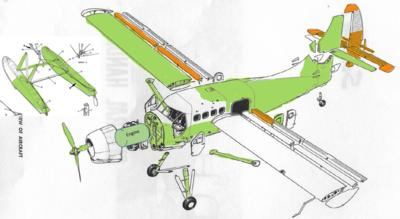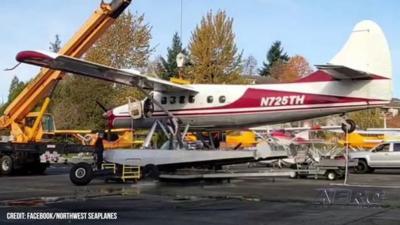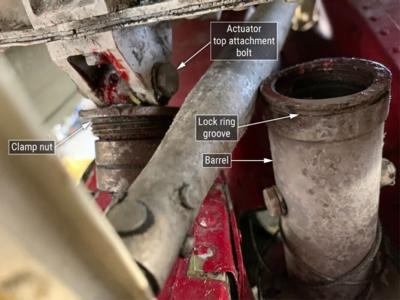Wed, Oct 26, 2022
Identifies Possible Safety Issue in Tragic Mutiny Bay Accident
National Transportation Safety Board investigators identified a possible safety issue with a flight control of the De Havilland Canada DHC-3 that crashed into Mutiny Bay, Washington on Sept. 4, 2022. Tragically, the pilot and nine passengers were fatally injured.

Investigators found (recovered airframe parts shown in green) the horizontal stabilizer actuator, which is part of the airplane’s pitch trim control system and is also referred to as the trim jack, had separated into two pieces. The actuator was found separated where the clamp nut threads into the barrel section. Examination of the threads inside the barrel and the threads on the clamp nut revealed that the two components separated by unthreading as opposed to being pulled apart in tension. A circular wire lock ring is used to prevent the barrel and clamp nut from unthreading. The lock ring was not yet located in the wreckage. This possible safety issue could result in a possible loss of airplane control.
At this time, the NTSB does not know whether the lock ring was installed before the airplane impacted the water or why the lock ring was not present during the airplane examination.

The NTSB, in coordination with the Transportation Safety Board of Canada, has asked that the manufacturer draft instructions for an inspection of the actuator to ensure that the lock ring is in place and properly engaged to prevent unthreading of the clamp nut. Those instructions will be released and provided to all operators of the DHC-3 airplane worldwide in a Service Letter.
The investigation into this accident will continue with examinations of both elevators in the NTSB Materials Laboratory; interviews of the FAA principal operations and principal maintenance inspectors assigned to the operator; a review of maintenance records, including historical records for accidents, incidents and service difficulty reports and interviews with maintenance personnel. An evaluation of lock ring failure modes and lock ring installation instructions will be accomplished in addition to an aircraft performance study.

The wreckage recovery operation was completed on September 30 with approximately 85% of the airplane recovered from the sea floor. A field examination of the wreckage occurred during the week of October 3, with follow-up activities in the NTSB Materials Laboratory in Washington, D.C. The horizontal stabilizer actuator and both elevators were shipped to the NTSB Materials Laboratory for further examination.
All aspects of the crash remain under investigation while the NTSB determines the probable cause, with the intent of issuing safety recommendations to prevent similar crashes. The information in the update is preliminary and subject to change as the investigation continues.
More News
From 2021: The Inside Skinny On What Being An ANN Oshkosh Stringer Is All About By ANN Senior Stringer Extraordinare, Gene Yarbrough The annual gathering at Oshkosh is a right of p>[...]
Video Showed That During The Takeoff, The Nose Baggage Door Was Open On May 10, 2025, about 0935 eastern daylight time, a Piper PA-32RT-300, N30689, was destroyed when it was invol>[...]
Get The Latest in Aviation News NOW on Instagram Are you on Instagram yet? It's been around for a few years, quietly picking up traction mostly thanks to everybody's new obsession >[...]
"I think what is key, we have offered a bonus to air traffic controllers who are eligible to retire. We are going to pay them a 20% bonus on their salary to stay longer. Don't reti>[...]
Aero Linx: Pilot Briefing The gathering, translation, interpretation, and summarization of weather and aeronautical information into a form usable by the pilot or flight supervisor>[...]
 Oshkosh Memories: An Aero-News Stringer Perspective
Oshkosh Memories: An Aero-News Stringer Perspective NTSB Prelim: Piper PA32RT
NTSB Prelim: Piper PA32RT ANN FAQ: Follow Us On Instagram!
ANN FAQ: Follow Us On Instagram! Aero-News: Quote of the Day (05.28.25)
Aero-News: Quote of the Day (05.28.25) ANN's Daily Aero-Term (05.28.25): Pilot Briefing
ANN's Daily Aero-Term (05.28.25): Pilot Briefing





